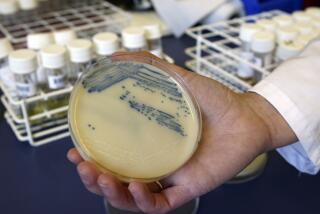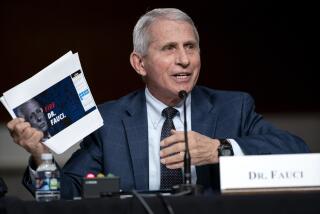Drug-free food
For nearly half a century, farmers have been feeding poultry and some livestock the same antibiotics -- penicillin, tetracycline, bacitracin -- used to treat sick human beings.
The drugs arenât given just to animals that are ill, however. They are dispensed at routine intervals to healthy animals to help them grow bigger and faster with less feed and to become more profitable at slaughter.
This practice has come under attack from a growing number of scientists, public interest groups and medical organizations that contend it is helping to fuel new strains of bacteria in humans, strains that are growing more resistant to the drugs developed to vanquish them. Many of these âsuper-bugsâ can infect people and cause fatal illnesses if antibiotics are no longer effective against them.
The campaign to stop the practice of giving antibiotics to healthy animals got a huge boost recently when one of the worldâs largest purchasers of meat and poultry joined the cause.
McDonaldâs Corp., which buys 2.5 billion pounds of poultry, beef and pork a year for its 30,000 restaurants worldwide, last month ordered its suppliers to eliminate by 2004 the use of antibiotics also given to humans, specifically when those drugs are used to make chickens, pigs and, less often, cattle grow faster.
âWe saw lots of evidence that showed the declining rate of effectiveness of antibiotics in human medicine,â said Bob Langert, McDonaldâs senior director of social responsibility. âWe started to look at what we could do.â
In effect, the marketplace has gone beyond what even the U.S. Food and Drug Administration tried unsuccessfully to accomplish in the 1970s -- eliminate the use of penicillin and tetracycline as growth promoters, an action that the U.S. Congress quashed.
Nevertheless, how much the policy will ease the resistance problem is a matter of debate.
âItâs a tremendous step in reducing the pool of drug-resistant bacteria,â said Dr. Stuart B. Levy, a professor at Tufts University School of Medicine in Boston and the author of âAntibiotic Paradox: How the Misuse of Antibiotics Destroys Their Curative Power.â
Moreover, he says, it will encourage other companies to follow suit. A company with McDonaldâs clout âsets a standard for a large amount of other products we consume,â said Levy, who founded the Alliance for the Prudent Use of Antibiotics, a nonprofit group that includes public health officials, veterinarians and doctors in 100 countries.
Trade associations in meat, pharmaceutical and veterinary fields branded McDonaldâs measure a marketing ploy. The move came a week after several McDonaldâs restaurants were picketed about the issue.
âWe feel these activists are clearly using the media to create concern where none need exist,â said Dan Murphy, spokesman for the American Meat Institute. âThe science says these products are effective the way theyâve been used for decades, and thereâs clearly no risk to the consumer.â
Trade organization representatives say they fear the activist groupsâ true motive is ultimately to ban all use of antibiotics in animals, which they say would place their livestock in danger from disease.
There is one point on which virtually everyone agrees: The emergence of the super-bugs in recent years has become a health-care crisis.
When antibiotics were introduced about 60 years ago, they could wipe out about 99% of bacterial infections. But as each new class of antibiotics was introduced, the bacteria eventually outwitted the drugs and evolved into more resilient strains, said Dr. Tom OâBrien, medical director of the microbiology laboratory at Brigham and Womenâs Hospital in Boston. The more antibiotics you use, the more you eventually lose, he said.
Germs that cause pneumonia, ear infections, acne, gonorrhea, urinary tract infections, meningitis and tuberculosis can now resist commonly used treatments.
For instance, the use of penicillin against staphylococcus infections, such as those that get into the bloodstream, had to be abandoned in the 1950s, OâBrien said. Then a new class of semi-synthetic penicillin was developed and lasted until about 1985, when the germs became increasingly tougher. Now, half of staphylococcal germs are resistant to that family of antibiotics. Staphylococcus bacteria are the biggest cause of infections in U.S. hospitals, attacking skin, burns and surgical wounds. They are beginning to show resistance to the latest and most powerful antibiotic, vancomycin, and if the staphylococcus super-bugs spread, said OâBrien, âit would be an enormous problem.â
Particularly at risk are the elderly and those with compromised immune systems. Linda Tollefson, deputy director of the center for veterinary medicine at the FDA, said that in the past, the FDA focused primarily on evaluating the effect on humans of antibiotic residues that might remain in the meat; the agency now is also paying a lot more attention to the antimicrobial resistance the drugs promote, she said.
One study, conducted by the University of Illinois, found that tetracycline-resistant bacteria retrieved from lagoons and in soil near a swine farm genetically matched the material in the guts of the swine, suggesting how the resistant bugs affect the environment.
Another study documented the effect of nourseothricin, used as a growth promoter, on one community. Although resistance to the drug was negligible in 1983, two years later, resistant Escherichia coli was found in the guts of pigs and in meat products and had spread to pig farmers, their families and the local community, causing urinary tract infections.
Once such drugs are approved by the FDA, withdrawing them can be difficult. For instance, the FDA has recommended a ban on a Cipro-like fluoroquinolone antibiotic that it had previously approved to treat sick poultry. Data from the federal Centers for Disease Control and Prevention show that resistance to Cipro in treating the most common causes of food poisoning jumped from 14% to 19% in 2001.
The FDA contends that people who eat poultry in which the drug has been used to combat respiratory infections are at great risk for contracting Cipro-resistant campylobacter, which is common in store-bought chicken. Cipro is a key drug used to treat food poisoning and came into the limelight in 2001 as an antidote for anthrax poisoning.
Bayer, which manufactures fluoroquinolone, is fighting the action, which wonât be ruled upon by an administrative judge for several months.
Most scientists agree that a much bigger factor in antibiotic resistance is over-use by humans; patients often ask doctors to prescribe them for colds and flu, and many doctors comply, even though these drugs are ineffective against viruses. Or patients fail to complete the full course of antibiotics when they take them for bacterial infections; any bacteria that arenât killed may become more tenacious.
The CDC estimates that about 150 million antibiotic prescriptions written each year for patients who are not hospitalized are unnecessary.
How much of this resistance relates to use in animals is controversial. Big killers, including hospital-acquired infections and pneumococcus, which causes pneumonia, are probably not related to antibiotic use in animals, most scientists say.
But such food-borne bacterial illnesses as salmonella; campylobacter, which causes bloody diarrhea; and E. coli, which causes urinary tract infections, are commonly associated with animals. The bacteria live in the guts of animals, although they donât make the animals sick. Salmonella causes more than 500 deaths a year and sickens 1.4 million people, according to Environmental Defense, a lobbying group that McDonaldâs consulted in formulating its policy; the company also consulted OâBrien, some suppliers and veterinary groups.
When animals are slaughtered, small amounts of feces can end up on the meat; if the bacteria arenât cooked or are put on a household surface, they can make people sick, says Rebecca Goldburg, senior scientist at Environmental Defense. If the bacteria are resistant, they can make antibiotics taken to treat a resultant illness less effective or ineffective.
Even finding out how much antibiotic treatment is being used to promote growth is difficult. The Animal Health Institute, the trade group that represents pharmaceutical makers, says that about 15% of the 21.8 million pounds of antibiotics its member farmers said they used in a 2001 survey went for âgrowth promotion.â
Public interests groups such as the Union of Concerned Scientists contend it may be as high as 80%. The FDAâs Tollefson estimates itâs likely somewhere in between, since far more animals take drugs for growth promotion than for infection treatment.
The line blurs in determining when the drugs are used for âgrowth promotionâ or for âprevention, control and therapeuticâ applications. A single drug can be approved by the FDA for all four uses; the difference is in the dosage allowed. So, if thereâs fear that some kind of epidemic will infect a hen house, farmers administer antibiotics as prevention or to control the spread.
Some skeptics have noted that it would be easy for suppliers to use the antibiotics as growth promoters but to list them as being used for control or therapy. McDonaldâs acknowledges this is a âgray area.â âWeâre quite aware of it,â Langert said, noting that its farmers still can use antibiotics when there is âclear evidence that some sort of disease can develop.â â
âBut weâre encouraging an overall reduction ... and recommending judicious use,â he said. Still, if drugs are not used, the animals are more likely to get sick, some industry groups contend. âAnimals that stay healthy carry fewer bacteria into the processing plant,â says Ron Phillips, spokesman for the Animal Health Institute.
At least one of McDonaldâs largest suppliers, Tyson Foods Inc., phased out antibiotics for growth promotion several years ago after concluding it could effectively raise the birds without them. The company also wanted to keep the antibiotics working more effectively for animals as well as for people by limiting their use, says spokesman Ed Nicholson. âWe want to have antibiotics to use when there is a real need for them to be used, not only for human medicine but for agricultural use, because they can effectively stop disease from becoming pandemic if needed.â
Instead, the company worked on improving conditions so the poultry would be less likely to get sick, including improving ventilation and installing temperature controls and better methods of watering the birds.
Some European countries, including Denmark and Sweden, banned their use as growth promoters five years ago, with no problems of increased costs, the FDAâs Tollefson said. The rest of the EU followed suit about a year ago.
More to Read
Sign up for Essential California
The most important California stories and recommendations in your inbox every morning.
You may occasionally receive promotional content from the Los Angeles Times.










